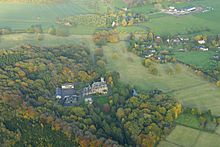Blaisdon Hall facts for kids
| Site of Special Scientific Interest | |

An aerial photograph of the hall
|
|
| Area of Search | Gloucestershire |
|---|---|
| Coordinates | 51°51′04″N 2°26′21″W / 51.851222°N 2.439124°W |
| Interest | Biological |
| Area | 0.07 hectare |
| Notification | 1995 |
Blaisdon Hall is a very special old building located in Blaisdon, Gloucestershire. It's so important that it's a Grade II* listed building, which means it's protected because of its history and unique design.
Part of Blaisdon Hall is also a tiny but very important nature area. It's called a Site of Special Scientific Interest (SSSI) because it's a home for many Lesser horseshoe bats. These bats are a type of small bat with a horseshoe-shaped nose. The hall is a breeding place for about one-fifth of all the Lesser horseshoe bats known in Gloucestershire! This makes it a nationally important spot for these animals.
The bats use parts of the hall like the roof space, roof tiles, and wooden beams to live and raise their young. Other types of bats, like Pipistrelle bats and Brown long-eared bats, also use the hall as a home.
Contents
History of Blaisdon Hall
Blaisdon Hall was first built in 1876. A man named William Crawshay had it constructed. Later, in 1907, it was made even bigger by P. Stubbs. In 1935, the hall was sold and changed into a school for farming.
What Does Blaisdon Hall Look Like?
The hall is a two-story building made of stone. It has a special style called Jacobean style, which was popular a long time ago. The roofs are made of slate. At the back of the building, there are two parts that stick out, creating a small courtyard between them. On the right side of the front, there's a tall, four-story tower. This tower has a special covered entrance called a porte-cochere, where people could drive their carriages or cars right up to the door.
Why is This Area Important for Bats?
Blaisdon Hall is just one of many important nature sites in the Forest of Dean and Wye Valley. These areas are super important for bats, especially Lesser and Greater horseshoe bats. They provide safe places for bats to have their babies and to sleep during the winter (called hibernation).
The Wye Valley and Forest of Dean are perfect for these bats. They have lots of leafy woodlands and sheltered valleys where bats can find plenty of food. There are also many underground caves and old mines. These dark, quiet places are ideal for bats to roost and raise their families.
This whole area, including Blaisdon Hall, is so important that it's recognized as a Special Area of Conservation (SAC) under European rules. This means it gets extra protection to make sure the bats and their homes are safe.
Protecting the Bats
Experts from Natural England keep a close eye on the bats at Blaisdon Hall. In 2011, they reported that the number of Lesser horseshoe bats was still strong. They counted 187 bats on August 8, 2011. It's hard to get into some parts of the roof where the bats live without possibly damaging their home, so they are very careful not to disturb them.

